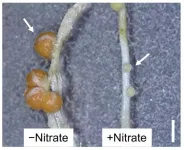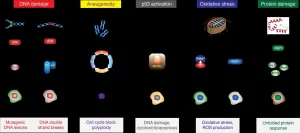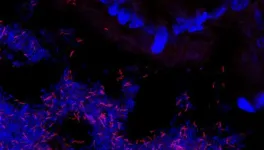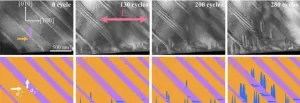To nodulate or not? Uncovering how nitrate regulates gene expression in legumes
Researchers from the University of Tsukuba find that nitrate-induced control of root nodule formation results from varying DNA-binding properties of specific proteins that control gene expression
2021-04-09
(Press-News.org) Tsukuba, Japan - Plants in the bean family (legumes) form nodules on their roots to take up nitrogen. Legumes will stop nodule production when nitrogen is plentiful (Figure 1), but precisely how nitrate presence controls nodule formation in these plants has been a mystery. Now, researchers from Japan have found that interactions between proteins and nitrate can induce and repress genes, controlling nodulation with potential applications in sustainable agriculture.
In a study published in April in The Plant Cell, a research team from the University of Tsukuba has shown that the different DNA-binding properties between proteins that establish nodule development determine if genes involved in symbiosis that govern nodulation turn on or off and that this gene expression is nitrate-induced.
Until now, there was an incomplete understanding of the molecular activity determining how legumes stop nodulation in the presence of excess nitrate. Previous research identified transcription factors (proteins that help turn specific genes "on" or "off") involved with nodule formation, but that's just part of the story.
"Building on the previous identification of transcription factors for proteins (known as NLPs) involved in nodule inception, we sought to answer the question of how symbiotic gene expression facilitating nodulation is controlled by nitrate," says senior author of the study Professor Takuya Suzaki. "We tested specific NLPs and found that they have overlapping functions, causing nitrate-induced control of nodulation."
To examine these molecular interactions, the researchers analyzed RNA molecules and plant traits using proteins from Lotus japonicus. They found that some proteins have dual functions, acting as master regulators for nitrate-dependent gene expression. They also identified new protein binding sites and compared them to previously known ones. Their findings reveal basic principles relating to NLP-regulated transcription of symbiotic genes inhibiting nitrate nodulation.
The research team emphasized additional questions. Some NLPs are found in cell nuclei in response to nitrate and stop nodule production, while others constantly aggregate in nuclei irrespective of nitrate levels. For the latter, it is unclear how they function exclusively in the presence of nitrate. The location of the NLPs in the cell matters because translation (when RNA is coded into proteins) happens in the cell's cytoplasm. If changes to proteins occur after the genetic code has been read (post-translational modifications), it could explain how these NLPs access protein-protein interactions and regulate genes.
"Uncovering how transcription factors influence gene expression has been a missing piece to the puzzle of understanding plant transcription regulation," Professor Suzaki explains. "Our discoveries bring us closer to knowing what is possible within these complex molecular relationships, but there is plenty left to untangle. Future research should aim to answer the question of how nodulation is regulated by other NLPs and in other plant species of interest."
INFORMATION:
The article, "Different DNA-binding Specificities of NLP and NIN Transcription Factors Underlie Nitrate-Induced Control of Root Nodulation," was published in The Plant Cell at DOI: 10.1093/plcell/koab103
[Attachments] See images for this press release:

ELSE PRESS RELEASES FROM THIS DATE:
2021-04-09
Two studies led by the Mental Health Unit of the Virgen del Rocio University Hospital and involving researchers from the US conclude that antipsychotic drugs could have a protective effect against SARS-CoV-2. For this reason, patients treated with these drugs have a lower risk of becoming infected or suffer a milder form of the disease if they do become infected.
Thus, a first descriptive epidemiological study of a sample of 698 patients treated with antipsychotics at the Seville hospital revealed that antipsychotic drugs could provide protection against both infection and the tendency to clinical severity of Covid-19 infection. "These are very interesting findings that reflect a clinical reality where we see few patients ...
2021-04-09
Since the beginning of the coronavirus pandemic, scientists and physicians worldwide undertook enormous efforts to understand the disease caused by the virus. In their latest collaborative study, researchers from the Max Planck Institute of Immunobiology and Epigenetics in Freiburg and physicians from the University of Freiburg Medical Center unveil a novel feature of COVID-19 immunity, which could have implications for future therapies. The study points to the involvement of Interleukin 33, an important danger signal, when immune cells encounter Sars-CoV-2 for a ...
2021-04-09
An international group of scientists led by the RIKEN Cluster for Pioneering Research have studied the chemical composition of 50 protoplanetary-disk forming regions in the Perseus Molecular Cloud, and found that despite being in the same cloud, the amounts of complex organic molecules they contain are quite different. Interestingly, the chemically rich young disks have similar compositions of organic molecules. These findings raise an important question: do solar-like systems share a common chemistry at birth?
It was once believed that complex organic molecules were rare in the universe, and that this rarity ...
2021-04-09
Imperial Brands scientists have utilised Toxys' ToxTracker suite of stem-cell based in-vitro assays, which provide mechanistic insight into the potential DNA damaging properties of chemicals, comparing vape e-liquid samples and their aerosols to combustible cigarette smoke.
Imperial scientists are the first to publish results using the ToxTracker system for the assessment of vape e-liquids and aerosols, and it forms part of the company's continuing research into the tobacco harm reduction potential of Next Generation Products (NGPs) such as vapes.
The assays help assess how product samples may impact cellular functioning across six reporter cell lines, picking up the tell-tale molecular signs of potential harm in the ...
2021-04-09
Glass is ubiquitous, from high-tech products in the fields of optics, telecommunications, chemistry and medicine to everyday objects such as bottles and windows. However, shaping glass is mainly based on processes such as melting, grinding or etching. These processes are decades old, technologically demanding, energy-intensive and severely limited in terms of the shapes that can be realized. For the first time, a team led by Prof. Dr. Bastian E. Rapp from the Laboratory of Process Technology at the Department of Microsystems Engineering at the University of Freiburg, in collaboration with the Freiburg-based start-up Glassomer, has developed a process that makes it possible to form glass easily, quickly and in almost any shape using injection ...
2021-04-09
The unpopular guests are already here. Hazel-, alder- and elm tree pollen sweep in over us during the early spring months, with birch pollen following in May. Then grass follows in June-July before mugwort pollen closes the season in late summer. All leading to more and more people suffering.
Over fifty years, the proportion of young Danes who sneeze, rub itchy eyes or suffer a blocked nose because of pollen has grown from 7-8 per cent in the 1970s to 24 per cent today. And for asthma, the proportion has risen from 4 to 12 per cent during the same period. ...
2021-04-09
Diet and the gut microbiome
With the consumption of a single type of vegetable such as spinach, hundreds of chemical components enter our digestive tract. There, they are further metabolized by the gut microbiome, a unique collection of hundreds of microbial species. The gut microbiome thus plays a major role in determining how nutrition affects our health. "So far, however, the metabolic capabilities of many of these microorganisms in the microbiome are still unknown. That means we don't know what substances they feed on and how they process them," explains ...
2021-04-09
Researchers at Lund University in Sweden have discovered that bird blood produces more heat in winter, when it is colder, than in autumn. The study is published in The FASEB Journal.
The secret lies in the energy factories of cells, the mitochondria. Mammals have no mitochondria in their red blood cells, but birds do, and according to the research team from Lund and Glasgow this means that the blood can function as a central heating system when it is cold.
"In winter, the mitochondria seem to prioritize producing more heat instead of more energy. The blood becomes a type of radiator that they can turn up when it gets colder", says Andreas Nord, researcher in evolutionary ecology at Lund University who led the study.
Until ...
2021-04-09
Ferroelectric materials are used in many devices, including memories, capacitors, actuators and sensors. These devices are commonly used in both consumer and industrial instruments, such as computers, medical ultrasound equipment and underwater sonars.
Over time, ferroelectric materials are subjected to repeated mechanical and electrical loading, leading to a progressive decrease in their functionality, ultimately resulting in failure. This process is referred to as 'ferroelectric fatigue'.
It is a main cause of the failure of a range of electronic devices, with discarded electronics a leading contributor to e-waste. Globally, tens of millions of tonnes of failed electronic devices go to landfill every year.
Using advanced ...
2021-04-09
During the acute phase of the COVID-19 pandemic, emergency department doctors, nurses and other frontline staff experienced unprecedented levels of stress and emotional exhaustion that included nightmares or insomnia, according to a UC San Francisco-led study of emergency departments across the country.
The study, among the first to assess mental health effects of the pandemic at a geographically diverse sample of emergency rooms, found that nearly one-fifth of the ER staff were at elevated risk for post-traumatic stress disorder (PTSD).
The study also reported that regular testing for COVID-19 helped to reduce stress among emergency personnel, particularly for those with previous positive antibody ...
LAST 30 PRESS RELEASES:
[Press-News.org] To nodulate or not? Uncovering how nitrate regulates gene expression in legumes
Researchers from the University of Tsukuba find that nitrate-induced control of root nodule formation results from varying DNA-binding properties of specific proteins that control gene expression





